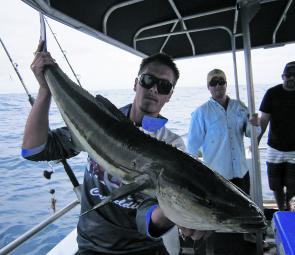As everyone knows, once again Mother Nature is against those wishing to get into some fish out wide. Another prolonged run of fresh northerlies followed by southerly blows has made getting a fishable day the hardest part of getting a feed, nevertheless the fishing has been pretty good.
Incredible has a brand new set of 20ft outriggers and we are in for some serious focus on the pelagics around Hutchies and some ground further north this summer trolling season. The poles have made light work of running 6 lines on the troll and first trip out recently saw Incredible regular John Wilkinson bag the first wahoo, 10kg+, for the year on the new configuration. It is an incredibly exciting way of chasing big fish – feet up and relaxing quickly turns to screaming reels and organised chaos! Great fun and will feature more action in the coming months.
Plenty of great wahoo, mahi mahi and yellowfin about and best to get out as early as possible to get a few runs in before the place becomes a car park. An early tide turn is most productive and the excitement of this form of fishing is well known judging by the amount of boats running through the area on a weekend day.
Wahoo (Acanthocybium solandri) live life in the fast land and are short lived. Studies have found that the average lifespan is just 2 years and a female reaches maturity at 92cm at just 7 months old. A recently tagged fish was found to have grown 10kg in just 10 months. The bigger fish you bag over 1.6m are most likely females and these big girls are the exception to the rule and can live to 9 years of age and reach over 2m in length. Speed? Well, they have it to burn. Studies have tracked smaller fish in the 113cm category at 77km/h, so the bigger 2m models are capable of speeds up to 100km/h. They need plenty of fuel for the fast life feeding on pelagic baitfish, flying fish and squid, and are voracious feeders and breeders with the girls producing up to 6 million eggs when spawning. Found around offshore reefs, coral drop-offs, current lines and FADs of the Great Barrier Reef, Coral Sea. They’re sweet eating and great fun.
Bottom fishing of late has been very good with catches of pearl perch dominating the box on the 60-70m line right throughout the area. Parrotfish and other summer type species, such as hussar, fusiliers and wrasse have also shown in good numbers around the rockier ground.
Undersize juvenile snapper and pearl perch have been a menace and can be avoided to a certain degree by using plastics such as the 7” jerk shad pearl whites on a 1.5-2oz jighead. Great fish being bagged using this method with pearlies up to 3kg quite common.
Cobia are also keen to grab hold of a floated plastic and are especially keen on the pink colours in the various manufacturers ranges. Floated down at the start of the drift the plastics are very effective on cobes if there are any about.
Current has been a problem over the past month with a strong flow to the south, which is pretty common in the summer months. Getting to the wider deeper grounds has been difficult but when able to get out there they have fished better than the shallower turf. The 90m ledge is worth a hit for quality pearlies, pigfish and juvenile snapper. Work along the line and you won’t be disappointed on bait or plastics.
A great reference tool to gauge what current and sea surface temperature can be expected is to take a look at the Bureau of Meteorology (BOM) website in the marine section. There you will find great interactive maps that demonstrate prevailing and forecast currents and sea surface temperatures, salinity and sea level anomalies. From that, clues can be obtained as to where the currents are flowing, where the water is warmer and will assist greatly in planning your day out to maximise your chances trolling and bottom fishing.
Like the much travelled wahoo you can easily see what currents and flows you’d expect would bring them south into our waters. Rivers of current pushing warm tropical water south just like a highway and the road that would be followed by a food source for pelagic fish. Just like winter when the whales are up and down the coast. You won’t see any for weeks then spend all day dodging them. They are using the current flows and the water temperature associated with it to make their journey easier and have some tucker nearby.
I’m no expert but the maps look very similar to a synoptic weather chart. Highs of warm water and lows of cold water and the interactions between the different systems. Something to think about to improve your chances.
Reads: 1104
Cobia are pretty keen on floated plastics, especially the pink colours.

Bottom fishing has been very good with catches of pearl perch dominating on the 60-70m line.

John Wilkinson bagged the first wahoo, 10kg+, on the Incredible’s new configuration.




